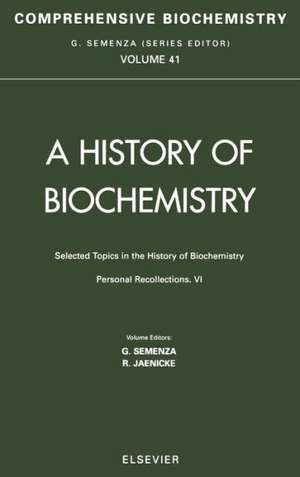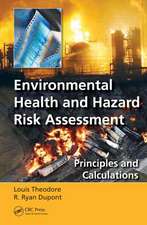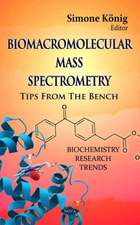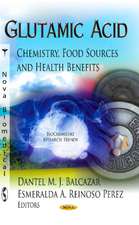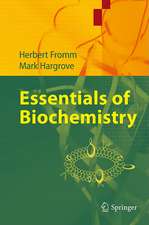Selected Topics in the History of Biochemistry: Personal Recollections VI: Comprehensive Biochemistry: Comprehensive Biochemistry, cartea 41
Editat de R. Jaenicke, G. Semenzaen Limba Engleză Hardback – 8 noi 2000
Preț: 1524.47 lei
Preț vechi: 2088.31 lei
-27% Nou
Puncte Express: 2287
Preț estimativ în valută:
291.69€ • 304.59$ • 240.88£
291.69€ • 304.59$ • 240.88£
Carte tipărită la comandă
Livrare economică 15-29 aprilie
Preluare comenzi: 021 569.72.76
Specificații
ISBN-13: 9780444505477
ISBN-10: 0444505474
Pagini: 784
Ilustrații: 1
Dimensiuni: 156 x 234 x 41 mm
Greutate: 1.27 kg
Editura: ELSEVIER SCIENCE
Seria Comprehensive Biochemistry
ISBN-10: 0444505474
Pagini: 784
Ilustrații: 1
Dimensiuni: 156 x 234 x 41 mm
Greutate: 1.27 kg
Editura: ELSEVIER SCIENCE
Seria Comprehensive Biochemistry
Cuprins
Preface to Volume 41
Contributors to this Volume
Chapter 1. Enemy Alien (M.F. Perutz)
Chapter 2. Kaj Linderstrøm-Lang (1896–1959)
(J. Schellman, C. Schellman).
A late-blooming scientist.
The Carlsberg Laboratory.
Lang's scientific career.
Linderstrøm-Lang, the man.
Acknowledgements and references for further reading.
References.
Chapter 3. Strife and Hope in the Lives of a Scientist
Couple
(M. Bárány, K. Bárány)
Years of 1939–1945.
The Szent–Györgyi Institute.
The Straub Institute.
The Weizmann Institute.
The Weber Institute.
Institute for Muscle Disease.
University of Illinois at Chicago.
Concluding remarks.
Acknowledgements.
References.
Chapter 4. Half a Century with TMV and Biophysics
(M.A. Lauffer).
Beginnings.
The Princeton years.
The move to Pittsburgh.
The Virus Research Program.
The Biophysics Department.
The Lipoprotein Program.
Hydration.
Form and function.
Deaning.
Inactivation of viruses by X-rays.
Fort Dietrich.
Compliments.
The McCarthy era.
Whiskers.
Hydrodynamics.
The middle 1950s to the middle 1960s.
The education enterprise.
Motion in biological systems.
Entropy-driven processes in biology.
The meaning of entropy-driven processes.
Retired living.
References.
Chapter 5. The Initial Step in my Science Career
(H. Fujita).
Prologue.
Getting a job at the Department of Fisheries.
Non-linear diffusion.
My stay in Leiden.
Moving to the United States.
Days on the Madison campus.
Epilogue.
References.
Chapter 6. Fascination in Modeling Motifs
(H. Kuhn).
1920s and 1930s.
Werner Kuhn and modeling polymer molecules.
Linus Pauling and attempts in quantum chemistry.
Niels Bohr and the branched &pgr; electron systems.
Tests and refinements of the free electron model.
Coupled oscillator approach.
The 1950s and today.
Supramolecular machines.
Scheibe aggregates.
Copying at the molecular level.
Manipulating electron and proton motion.
Origin of life.
Concluding remarks.
Acknowledgements.
References.
Chapter 7. Erik Jorpes — A Pragmatic Physiological
Chemist
(V. Mutt, M. Blombäck).
Erik Jorpes' childhood and youth.
Jorpes as a grantee in America: nucleic acids, endocrine secretion of
pancreas, secretin, insulin, and heparin.
Erik Jorpes and other studies by his colleagues in clinical medicine.
Other important research in the department.
Edman and protein characterization.
Viktor Mutt's recollections of Erik Jorpes in the research environment
in 1944.
Recollections of Margareta Blombäck on the working environment in
the 1950s and the early 1960s.
Erik Jorpes as historian and teacher.
Jorpes and the international research community.
Jorpes as a person.
References.
Chapter 8. Half a Century Between Carbohydrates and
Proteins
(N. Sharon).
Introduction.
Family and childhood in Poland.
Growing up in Palestine.
Choosing biochemistry as a profession.
How I started with carbohydrates.
Into protein biosynthesis.
Returning to carbohydrates.
Learning about enzyme mechanisms.
Back in the Laboratory for Carbohydrate Research.
Lysozyme, peptidoglycan and penicillin.
My first glycoprotein and first lectin.
Obscure proteins as markers for cancer cells.
Chemical and biological characterization of soybean agglutinin.
Enter peanut agglutinin.
A life-saving application.
Bacterial surface lectins and infectious disease.
Carbohydrates in anti-adhesion therapy.
Early evidence for innate immunity.
Atomic basis of carbohydrate–protein interactions.
The first galectin.
Spreading the gospel.
Acknowledgements.
References.
Chapter 9. Interplanetary Travels
(G. Schatz).
Mars.
Jupiter.
Mercury.
Saturn, Pluto or beyond?
Acknowledgements.
References.
Chapter 10. A Life-Long Quest for Biochemical
Regulation (Helmut Holzer, 1921–1997)
(K. Decker).
Growing up.
First contacts with science.
Studies on the regulation of glycolysis.
Professor of Biochemistry in Freiburg.
The thiamine-pyrophosphate-activated oxo compounds.
The regulation of glutamine synthetase of E. coli.
Involvement in university politics.
The function of proteolysis in cellular regulation.
Regulation through chemical modification of enzymes.
The trehalose project.
Final remarks.
Acknowledgements.
References.
Chapter 11. A German Biochemist in the Twentieth
Century
(K. Decker).
The beginning.
A new start after World War II.
Joining Feodor Lynen.
Do it yourself!
Nicotine – an early favorite also in Freiburg.
The fascinating life without oxygen.
Paying tribute to the genius loci.
A memorable episode – sabbatical in Michigan.
Chance strikes when it is least expected.
The career of an amino sugar.
The liver, an organ for living.
How to organize a research team?
Service to scientific organizations.
Kupffer cells are not for plumbers.
Shrinking stars.
Academia.
Is research on nicotine addictive?
Getting cooler.
Indian summer.
Nicotine – A and &OHgr;.
Resumé.
References.
Chapter 12. Life with tRNA, Chromatin, Immunoglobulin
Genes: Recollections of a German Molecular Biologist
(H.G. Zachau).
Family background and early education.
Student years.
Postdoc in the US.
Exploring the non-scientific world.
tRNA research in Munich and Cologne 1958–1966.
1961–1966, one of the golden ages of molecular biology.
From tRNA to chromatin.
Teaching.
Society games, councils, boards and relations to industry.
Immunoglobulin genes.
Last years in office and retirement.
Epilogue.
References.
Chapter 13. A Biochemist by Chance:
Alessandro Rossi Fanelli, Builder of the Roman School of
Biological Chemistry
(G. Amiconi).
Biochemist by chance.
The years of apprenticeship.
Sentimental education.
Seeds of glory on a field well-tilled by illustrious predecessors.
In the chair at Pavia.
In Rome, starting again from zero.
After the solid foundation, the grand construction.
Official recognition.
Teaching: without enthusiasm, but seriously.
Two lines of research among the many.
Not only scientists but also managers.
Human quality and surroundings.
Acknowledgements.
References.
Chapter 14. The Early History of Biochemistry in Israel
(N. Sharon).
Introduction.
The beginnings.
Andor Fodor – primus omnium primorum.
Proteins and enzymes.
Only a few immigrated.
The study of lipids.
Carbohydrate research pioneer.
From polysaccharides to signal transduction.
Chemistry of macromolecules.
Sugars, polyelectrolytes, mechanochemistry and membrane
transport.
Synthetic polypeptides as protein models.
Imported topics.
Rapid growth.
Concluding remarks.
Acknowledgements.
References.
Name Index.
